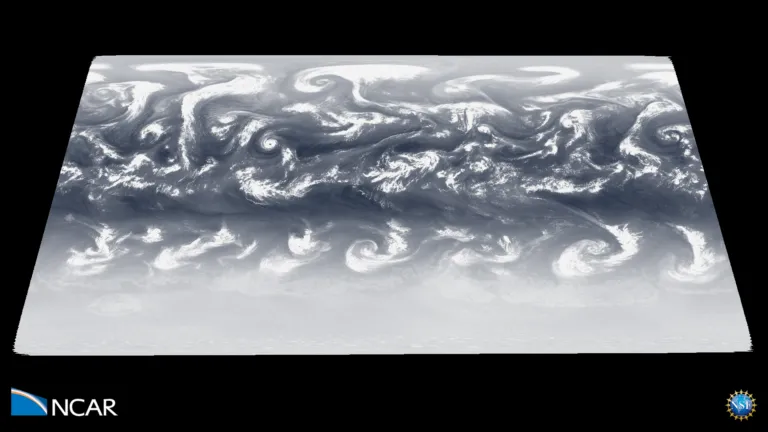
Aquaplanet simulations—as their name suggests—are idealized representations of Earth where the planet is covered entirely by water. The absence of continents, while unrealistic, provides a clean laboratory where weather systems can develop, evolve, and dissipate as they would do over Earth’s oceans. This kind of simulation is, therefore, useful for learning about the fundamental processes that govern the evolution of weather systems.
Here, the Model for Prediction Across Scales – Atmosphere (MPAS-A) was used to create an aquaplanet simulation with 3-km cell spacing (considered “convection-permitting” resolution) in the tropics transitioning to 15-km cell spacing elsewhere. This simulation develops a climate and weather systems that are very similar to those observed on Earth: a line of intense thunderstorms in the tropics, occasional tropical cyclones that migrate westward and poleward, an area of relatively quiet and dry weather in the subtropics, and a region of very active cyclones in the middle and polar latitudes. NCAR scientists are using this simulation to uncover the processes that favor the formation of powerful tropical cyclones—a very active area of research where our knowledge is very limited.
Outgoing longwave radiation is used here as a proxy for clouds. The MPAS-A aquaplanet simulation starts from a quiescent state without any weather systems. As the simulation progresses, the combination of a sea-surface temperature condition and model physics lead to the development of weather systems everywhere. By one month, the weather patterns resemble those of real Earth. Of particular interest, tropical cyclones form in the deep tropics, move westward and poleward, and dissipate as they leave the warm tropical oceans.

Rosimar Rios-Berrios (NCAR/MMM)
NCAR Strategic Capability project NASP0010
NCAR/MMM Director’s Reserve project NMMM0042
Model for Prediction Across Scales-Atmosphere (MPAS-A).
A Multi-scale Nonhydrostatic Atmospheric Model Using Centroidal Voronoi Tesselations and C-Grid Staggering. William C. Skamarock, Joseph B. Klemp, Michael G. Duda, Laura Fowler, Sang-Hun Park, and Todd D. Ringler. 2012 Monthly Weather Review, 240, 3090-3105, doi:10.1175/MWR-D-11-00215.1
Post-processed data from this and other MPAS-A aquaplanet simulations are available at https://doi.org/10.5065/cam1-v353
Rios-Berrios, Rosimar, Medeiros, Brian, Bryan, George. (2020). Aquaplanet simulations using the Model for Prediction Across Scales (MPAS) version 6.2. Version 1.0. UCAR/NCAR – DASH Repository. https://doi.org/10.5065/cam1-v353. Accessed 22 Feb 2021.
Matt Rehme (NCAR/CISL)
Imagery produced by VAPOR (www.vapor.ucar.edu), a product of the Computational Information Systems Laboratory at the NSF National Center for Atmospheric Research.
Rios‐Berrios, R., Medeiros, B., & Bryan, G. H. (2020). Mean climate and tropical rainfall variability in aquaplanet simulations using the Model for Prediction Across Scales‐Atmosphere. Journal of Advances in Modeling Earth Systems, 12, e2020MS002102. https://doi.org/10.1029/2020MS002102